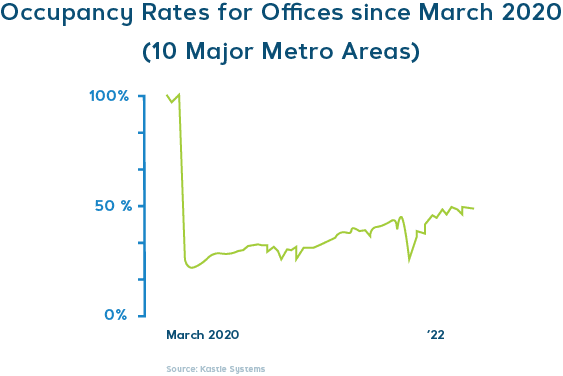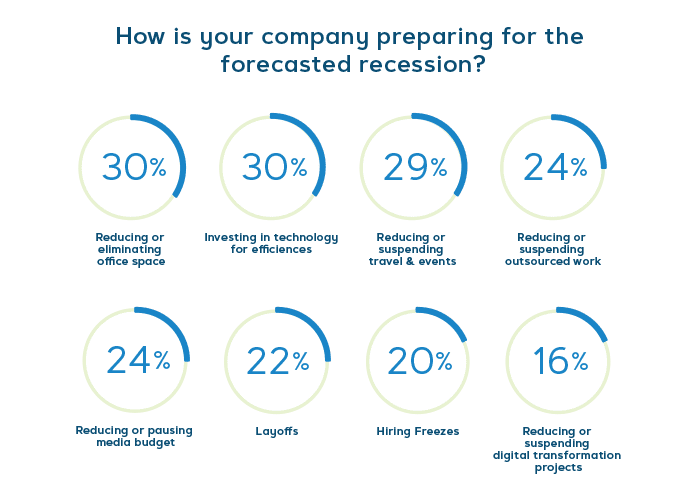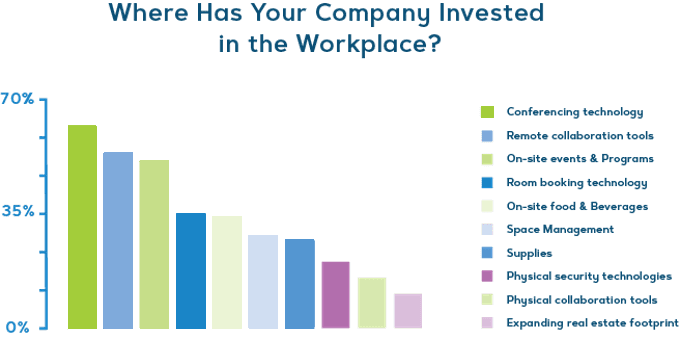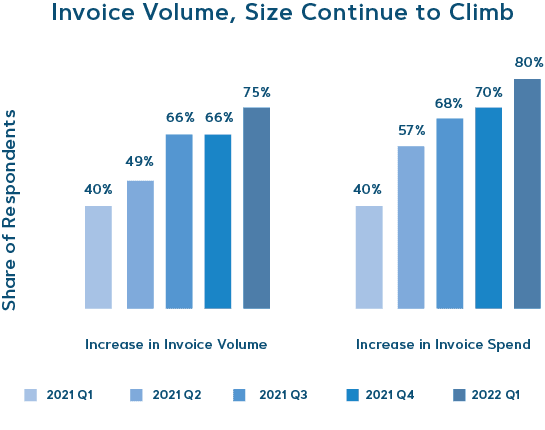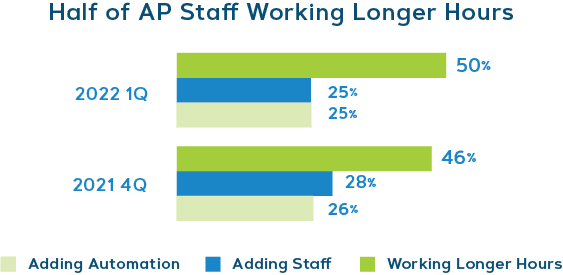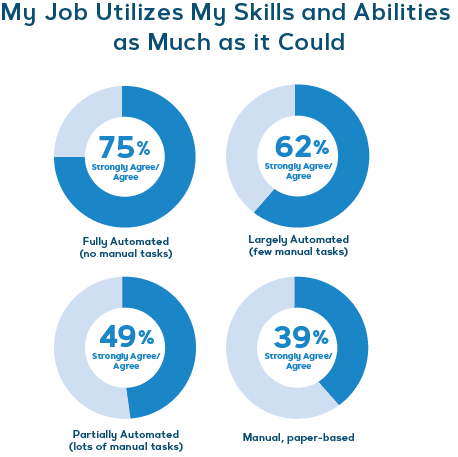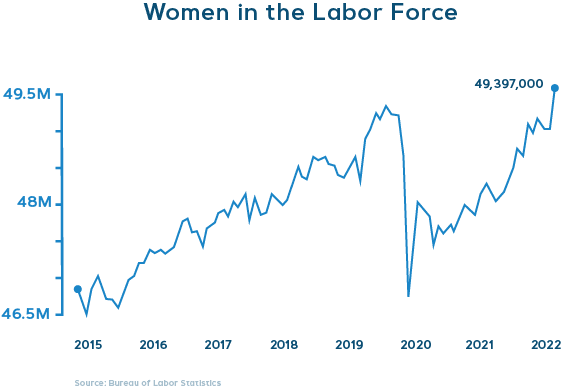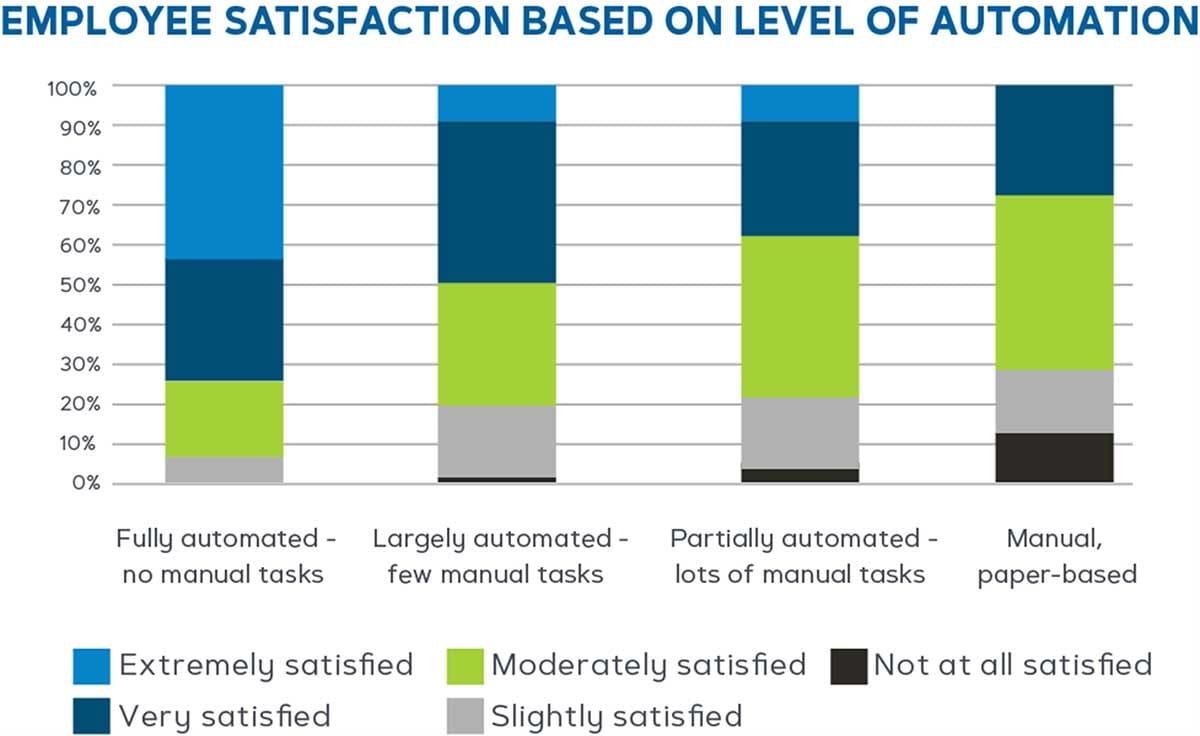In the first episode of the “Net 30” podcast by the AvidXchange Podcast Network, host Chris Elmore sat down with Rhonda Greene and Gary Larson to discuss the future of accounts payable (AP).
Using more than 50 combined years of accounts payable experience, Elmore, Greene and Larson covered what we’ve deemed the three main pillars of AP “work” … the workplace, the workload and the workforce that executes the AP function.
Nine key data points were used to assess the current state of AP and analyze what each could mean for the future of the profession.
Listen to the full episode now (you can find a complete transcript at the bottom of this post) or dive into the data and analysis below:
The Future of the Accounts Payable Workplace
CHART 1: Work-from-home options leave office buildings half-empty
This data below is from Kastle Systems, a company that tracks actual key card swipes into office buildings in major metro areas. This chart shows that, well, most office buildings are filled with empty desks:
This chart tells us two things:
- Employees are taking advantage of hybrid work options
- Companies are letting them
Recent data also shows companies are embracing the cost savings associated with hybrid employees, as opposed to full-time in-person, and using that information to cut costs as we prepare for a potential recession. One study conducted by IWG, shows a company saves an estimated $11,000 per year per hybrid employee. The primary savings will come from increased productivity, lower real estate costs, reduced absenteeism, turnover and better disaster preparedness.
CHART 2: Companies plan to reduce physical overhead
Recent AvidXchange research revealed 30% of companies are preparing for a potential recession in a number of ways, most commonly, the reduction or elimination of office space. Not coincidentally, “investing in technology for efficiencies” was also high on the list.
This means more American workers could be sent home and expected to utilize new tech that empowers them to be efficient contributors away from a central location.
With this in mind, it may be a good idea to start planning for a “decentralized” future by “centralizing” important functions like AP in a cloud-based, digital environment.
CHART 3: Office investments focus on remote capabilities
This 2022 Workplace Trends survey from Envoy shows where companies are investing dollars to improve their workplace. As you see, free snacks and new dry-erase markers are way down the list, while the two largest investments are actually things that make it easier to stay away from the office — conferencing tech and remote collaboration tools.
This means many of the tools are now in place to empower remote and hybrid workforces. Teams calls and Zoom meetings are now more common than face-to-face brainstorms.
Moving forward, more tech will likely be adopted and developed to empower other functions to run remotely in a similar way.
The Future of the Accounts Payable Workload
CHART 4: AP departments continue to handle more invoices, more money
This benchmarking data from IOFM shows invoice volumes and invoice spend have steadily increased since the start of 2021.
This means AP teams are doing more work and handling more money. The job is harder. It requires longer hours. The risks involved are greater with more volume and more cash flowing through the department.
This means AP teams need the tools to work faster, more efficiently and more safely.
CHART 5: AP departments are logging serious overtime
Additional benchmarking data from IOFM shows half of surveyed finance teams have opted to work longer hours to handle that increase in volume and spend we just covered.
This data shows organizations are two times more likely to ask their existing team to work overtime than they are to add staff or adopt automation technology to reduce the burden placed on accounts payable folks.
CHART 6: Old-school AP departments produce unfulfilled employees
This AvidXchange data shows how strongly (if at all) AP pros believe their skills and abilities are being utilized in their role. You see 75% with full automation believe they have what they need to reach their full potential. As the level of automation dwindles, so does that percentage.
This means AP employees want to do more than key in data. They are capable of more than licking stamps and printing checks. They want the time to be strategic influencers. Real decision-makers. Impactful contributors.
Luckily, given what we’ve seen in the other data highlighted in this post, the future may present those opportunities as more companies embrace hybrid work and empower their accounts payable with the tools they need to be efficient, happy, purpose-driven team members.
The Future of the Accounts Payable Workforce
CHART 7: Women are back in the workforce – which is good for AP departments
Before we talk about what AP professionals want, let’s talk about who they are — women.
- 79.4% of all accounts payable associates are women
- 71.3% of all accounts payable leads are women
- 76.0% of all accounts payable managers are women
This chart from the Bureau of Labor Statistics shows more than 2 million women left the workforce at the start of the pandemic. It took two years, but that number has since recovered.
This means more of the AP workforce is back after taking time to care for elderly family members impacted by the pandemic, help children learn during remote schooling or any other number of reasons.
Their return is a very good thing for short-staffed AP departments, but these professionals want very different things today than they did in early 2020. They are not the same people in many ways.
CHART 8: Today’s working professional wants flexibility
This is data from McKinsey’s latest American Opportunity Survey of more than 12,000 workers in the US. When asked what factors are most important when choosing a new job, a flexible working arrangement ranked third in importance behind pay and career opportunities – ahead of several factors including better health insurance and more paid leave.
This means:
- Employees want to maintain the flexibility many of us enjoyed over the last two years
- The option to skip the morning commute, have breakfast with your kids, walk the dog at lunchtime and work from home two days each week is now more valuable than five extra days of PTO
- Companies need to empower and promote a flexible culture if they want to attract and retain the best talent
Overall, employees just want to find satisfaction in their roles and working environment, which means steps must be taken to empower a hybrid or fully remote department. Enter automation.
CHART 9: Given the right tools, employees are far more satisfied with their role
In 2022 we ran our first “AP Professional Career Satisfaction Survey” of nearly 500, you guessed it, AP pros in the Institute of Finance and Management’s professional network.
We asked them to rate their level of job satisfaction and cut the data based on the level of automation used in their day-to-day work. Simply put, you hope to be in the blue sections of either extremely or very satisfied.
This means more automation equals more satisfied employees. Plain and simple.
It confirms what we all know, and that’s the manual, repetitive work drives the dissatisfaction of AP professionals. This means finance departments need to take a serious look at not only the potential efficiency gains and cost benefits of automation that show up on balance sheets, but the impact it can have on the happiness of employees.
Data shows happy employees with access to automation work harder, stick around longer, and according to our survey like their bosses a whole lot more (nearly six times more, to be exact).
I believe my direct supervisor values my contributions and cares about my development:
- 69% of those with fully automated systems “strongly agree”
- 12% of those with manual “strongly agree”
I believe my organization’s executive leadership values my contributions and cares about my development:
- 69% of those with fully automated systems “strongly agree”
- 12% of those with manual systems “strongly agree”, while 20% “strongly disagree”
Moving forward, finance leaders must understand the changing expectations of AP professionals, who hold more power than their employer in many cases because there is a real need for the skillset. To foster satisfied, effective teams, provide the flexibility and tools they need.
For a complete analysis from the “Net 30” podcast, download the episode here.
LISTEN NOW:
Complete transcript:
Net 30: Looking into the Future of Accounts Payable
Host: CHRIS ELMORE
Guests: RHONDA GREENE, GARY LARSON
00;00;05;28
CHRIS ELMORE
Welcome to the Net 30 podcast. I’m Chris Elmore, AvidXchange’s chief evangelist. AvidXchange is a leading provider of accounts payable automation, software and payment solutions for middle market businesses and their suppliers. Now I’ve spent 22 years in this space and I’ve had over 8,000 conversations with accounts payable departments, and I’ve actually written eight books on the accounts payable process.
And if you want to clear a room at a party, you tell them you’ve written a book about accounts payable.
Each month the Net 30 podcast is going to unpack the problems, solutions and innovations impacting the careers of financial professionals with a focus on accounts payable. And we’re going to do this in less than 30 minutes. Today is our very first episode.
I’m sitting down with two of the smartest people I know to discuss the state of accounts payable and what the future may hold for the professionals that do this work. So, let’s introduce my guests for this episode of Net 30.
Future of Accounts Payable: INTRODUCTIONS
00;01;09;07
CHRIS ELMORE
Gary Larson, you look giddy.
GARY LARSON
Can you tell I’m excited and tense? I get to spend time with Rhonda Green. It’s a good day.
CHRIS ELMORE
I thought you were going to go for me, but that’s okay. That’s all right. It’s okay. Rhonda did … What do you call that? Hard hands?
RHONDA GREENE
Heart.
CHRIS ELMORE
It’s a podcast, so I guess no one really saw that.
RHONDA GREENE
It was just for Gary.
CHRIS ELMORE
Oh, it was? Yeah. You got heart hands right out of the gate. A little Justin Bieber. So introduce yourself, Gary.
GARY LARSON
Hey, everybody. Gary Larson here with the sales readiness team. Just excited to spend time just talking about some of the future of AP with you.
CHRIS ELMORE
There you go. And we also have a true celebrity in the studio today. And in the AvidXchange podcast studio, Rhonda Greene. Now, when I first met you, you weren’t Rhonda Greene.
RHONDA GREENE
No, I was not.
CHRIS ELMORE
Yes. And you went to Home Depot. You met a boy. Got married?
RHONDA GREENE
I got married.
CHRIS ELMORE
I know lots of personal stuff.
RHONDA GREENE
It was actually Lowe’s.
CHRIS ELMORE
Okay. It was like you met a boy at Lowe’s.
RHONDA GREENE
Yes.
CHRIS ELMORE
And then you got.
RHONDA GREENE
Married and the rest is history, shall we say?
CHRIS ELMORE
So what what’s the folks know about you, Rhonda Greene?
RHONDA GREENE
Well, I have been at AvidXchange now for 10 and a half years, which is hard for me to believe because the time has just flown. But right now, my current role, I’m a principal solutions consultant, so I work with our sales team to demonstrate our products and talk to who I’ve always viewed as my peers other people in the AP space and help them understand that automation is the way to go.
CHRIS ELMORE
There you go now. Gary, you’ve been an AvidXchange for eight years. I’ve been an AvidXchange for 22 years.
GARY LARSON
You’re better than us.
Future of Accounts Payable: WORKPLACE
CHRIS ELMORE
You know. I don’t know. I don’t know what that is. My AvidXchange tenure is something I’m actually pretty proud of. And if you asked Mike Praeger if he thought I would get this far
I remember when I got my 20-year anniversary, we were at a like an all sales meeting and he said, I never thought he was going to make it past three. And he’s right because I get distracted easily. I am actually prepared for this moment. And there’s three things that we want to talk about. We want to talk about workforce, workload and workplace.
Let’s start at the top of this, which is so there’s three things that we’re going to talk about workplace, workload and workforce. So at the top of this is are the physical locations. Kastle Systems did a study on actual key card swipes. And what they found out is that about half of buildings are completely empty. Recent AvidXchange research revealed 30% of companies are preparing for a potential recession by reducing or eliminating office space.
And a 2022 Workplace Trends survey by Envoy shows where companies are investing dollars to improve their workplace. Free snacks and new dry erase markers, which I’m a big fan of both of, are way down on the list. While the two major the two largest investments are actually things that make it easier to stay away from the office.
One is conferencing technology and two is remote collaboration tools. And Rhonda, I’ll go to you first for reaction. You know, what do you think this is doing to our world?
RHONDA GREENE
You know, I think I actually think it’s a good thing because people like me that we’re in my situation. To Gary’s point, I would have quit and probably some of these people now that have all of these especially women who are raising children and doing all of these other things.
They need that work life balance. So I think if anything, especially now with technology, with automation, things that we never thought was possible 20 years ago, I never in a million years would have thought that an app team would ever be able to work remote because they were touching so much paper. And so to me, it is it’s a wonderful thing and I think people are much happier because of it.
And I think that the result is everyone is doing a better job, they’re more satisfied and they’re appreciated.
CHRIS ELMORE
So Gary, I need to get your reaction on this. But before I do, if you’re dipping back into your experience, you ran an AP department. How many people were there?
RHONDA GREENE
I ran a couple of different AP departments. And at one time I was over 12 different AP specialists. And that was back when everything was 100% manual. That was before automation, before it even existed. And so you had to have people on site to open that mail and to file because you had to write and retain all of your invoice images, your check copies, all of that.
So you had people that just filed. And so obviously with that level of manual work, there was no working remote. So that’s why for me, it’s exciting to see that it’s come this far and that these people are able to now with the help of technology.
CHRIS ELMORE
That leaves a pretty big void, Gary, in the office space world.
GARY LARSON
Well, it does, but technology has stepped up remarkably well, like Microsoft Teams, Zoom. I think Zoom is like you have the statistics, it went from like 10 million to like a billion users per month.
CHRIS ELMORE
It was in December 2019 it was 10 million users that month. And then in 2020 March, ah, excuse me, May, it was 200 million and then June is 300 million.
GARY LARSON
How is the exponential growth then? So that means we have the technology to support the 12 individuals that would have been on Rhonda’s team to work remotely for you to still feel connected to the business, to still be able to work and to perform. And all the state, all of the data that we’ve seen, all the surveys, all of that stuff shows that on average, people work actually perform better in a hybrid environment.
Their satisfaction goes up, their retention goes up. We’ll talk a little bit about some of that stuff, but I think there is a gap, but there are certainly an opportunity to leverage this technology to where it’s becoming the norm. And as you interview people, they’re almost expecting to be able to work one day, at least a couple of days from home.
Future of Accounts Payable: WORKLOAD
CHRIS ELMORE
Moving on to workload handled by the accounts payable departments. Here’s a few numbers by our pals from IO FM to set the table. I’m looking specifically at you, Gary, to just react first, is that when COVID hit in 2020, invoice volume fell by 22%, and then it started to make this remarkable climb.
And it started in Q1 of 2022. There were now, as we’re sitting now, five consecutive quarters of growth. So but the thing is this because of inflation, not only is the volume growing, but the dollar amounts are growing. So accounts payable, people are being asked to work on more stuff. And it says here that the thing that companies are choosing is overtime versus adding staff and adding automation.
And that means that they’re working with higher dollar amounts and higher volume.
GARY LARSON
So the same amount of people are doing more work and handling more money, right? Which is more risk for the business and I remember when I started AvidXchange, we still have a part of one of our teams on the third floor that was keying financial data on a spreadsheet.
And if there was any mistake on that spreadsheet like it was, it could go from like a $12,000 invoice to $120,000. If you think of businesses doing that in mass and volume and you’re asking people to do that more frequently, and now those numbers are getting bigger, that’s a tremendous amount of risk you’re putting on people when you could potentially automate a lot of those errors in keystrokes and.
CHRIS ELMORE
You ever punch in an extra zero in your career. Rhonda.
RHONDA GREENE
Yes, I think anyone that has done manual data entry has had some sort of issue like that. And especially when you’re working in that manual world as a manager, you have to almost account for that and you have to come up with controls, reactive controls, to be able to look for these things in the back end, to try to catch them because you know they’re going to happen, right?
So you need to do extra review looking over the invoice register to see everything that was entered, making sure nothing looks out of line. Like we normally pay this company 1500 dollars and now this invoice is 15,000. That doesn’t look right. But so, you’re having to account for that that I entered that knew those manual errors what’s going to happen.
GARY LARSON
So you’re asking a person to manually check the manual work.
CHRIS ELMORE
I mean. That’s right. Right. And that’s why you have checks and balances.
You said something to me years ago that’s always stuck with me. You said lots of things, but this one is accounts payable never gets recognized as I’m doing air quotes, but accounts payable never gets recognized until someone does something wrong.
RHONDA GREENE
Oh, that is the truest statement I have ever said. Because AP is such an important department because all of the invoices are flowing through in the expense reports. And as long as everything is just ticking along, it’s great. But the first time that someone is paid late or you miss a discount or you code something wrong, then you know, you’re like, What in the world?
AP, oh my gosh. AP did this and that, and there’s all of this focus on, oh my gosh, AP made this error because again, when you’ve got a department that’s working with money going out the door it’s heavily, heavily scrutinized, and audited as it should be. But that’s just something I’ve always said. So I always made sure as a manager over the years that I let my team know, hey, I know how important you are and all the good work that you do.
Future of Accounts Payable: WORKFORCE
CHRIS ELMORE
So let’s talk about these people. Did you know that 80% of accounts payable professionals are women? Yes. You know that you did. And then but the other thing is, when the pandemic hit, 2 million women left the workforce, but it’s now recovered. And in a recent study, 12,000 workers were asked when they’re choosing a new job.
So the idea is a bunch of people left, now they’re coming back and they’re choosing a new job. There’s an actually, I have a statistic here. I have I have the numbers here. But if you look at it when they first choose a new job, dollar money is is big. But the thing that I wanted to get you to react on is if you look at everything on this chart and sorry, folks, that you don’t see the chart, but I’m going to explain it.
If you look at everything on that chart and take out everything that’s financially driven, it comes back to working conditions.
RHONDA GREENE
Oh, absolutely.
CHRIS ELMORE
Working environments.
RHONDA GREENE
Right. And I also love the better career opportunities because while data entry is very important it’s tedious and boring and it’s the same thing over and over again. So of course, AP folks want to do more, right? So that is absolutely it tracks with everything that I’ve known and everything that I continue to hear today.
The flexible working arrangements is number three because again you can do hybrid work now where you couldn’t do it before, so why not do it and give those people what they’re looking for.
GARY LARSON
Then you have this workforce predominantly of women in the AP space that are having to consider the cost of health care or for their kid’s child care, for their kids. And in the Charlotte area, it’s like 1200 dollars a month on average. So is it is my income of doing whatever work that is going to offset that? And oh, by the way, you’re making me drive 45 minutes each way at $4.50 a gallon.
So these all of these things start to factor into whether or not people want to come into the work environment and employers that have more flexibility with not only your work environment, but your office hours and also providing you an opportunity to grow. Because I don’t want to consistently just do this one thing. I want to see myself grow.
They’re the ones that are going to do generally the best.
CHRIS ELMORE
And then when we started digging, we started digging into technology. We started finding, Gary, that people where their employers have invested heavily in automation, specifically, their job satisfaction goes up.
GARY LARSON
There is a huge correlation in the data to show employee satisfaction tied to automation. And you would almost think that the knee jerk reaction for some people to think that it’s inverse, that it’s like, oh, it’s taking my job, I’m afraid. And what you actually find is the inverse is where it’s taking all of the crap I don’t want to do, and it’s given me the value-add activities that are left over, plus the additional stuff I never got to do.
I mean, I think if Rhonda had her team, there were probably some individuals in that 12-person roster, who said that’s like me. And were they ever underutilized? We got so much paper to go through. I would love to give you this other project, but you got three feet of paper you got to pay.
CHRIS ELMORE
Is it true, Rhonda?
RHONDA GREENE
Absolutely, it’s true. I mean you wanted to be able to grow your team, but at the same time, the job has to be done. And when it takes so long to open an invoice and then look at it and figure out how it needs to be coded. And then you have to scan it in and then you’re emailing it to someone you don’t have time to let someone go and shadow you.
You do the best that you can because you don’t want to lose these people. But the single greatest thing is being able to, and this this is exactly how I felt about the payment services division here, is being able to hire more talent that has that go-getter attitude and help them get to where they want to be.
That at my age now, that is so important to me. It’s so fulfilling and rewarding. And I hear this all the time when I talk to customers, you know that they’re not looking when they’re looking at automation, they’re not looking to come in and mow down half their workforce. They love these people. They’ve worked with them for years. And they want them to be able to do other things. And so it’s exciting to know that even though you can obviously cut headcount with automation, but to a lot of folks, that is not the driver at all.
GARY LARSON
So I was going to say I’m thinking about some of my notes and I was we’re talking about the leveraging extra days of PTO. There are a lot of organizations that are going to unlimited PTO. Yeah. Like if you need it, take it. Right. That’s an impossible concept for Rhonda’s team back in the day.
CHRIS ELMORE
Is it?
GARY LARSON
That would maybe cripple them.
CHRIS ELMORE
Maybe the business could announce we’re doing unlimited PTO, but you have to get your work done.
GARY LARSON
Well, yeah, but guess what? The work was never done right. Like, every day you came in, there was still a stack of paper that you had to get through. So that those individuals would have never felt safe and the leaders would have never felt safe saying, go ahead and take PTO, that’s fine, because the amount of manual work that needed to be done was unending.
And what you’re seeing now with companies that are offering these creative, flexible work life packages is they’re doing that because they can manage the work virtually, remotely. And you know, when the work starts, when it stops versus it’s just an ending pile of just paper falling on you.
RHONDA GREENE
That’s right. And you know, the daily grind, as we would call it, that all has to be done. But then every month you’ve got a month-end that just adds additional work to you. But you still have to get your normal daily work done. So you’re going to have to stay over to do that.
And then year-end is just a complete crazy time where normally you’d love to give people off for the holidays, but nope, can’t do it because we’ve got to get all of these invoices entered and then you’ve got 1099 season and the auditors are coming in and it’s so the stress level is so high all while you’re maintaining that day-to-day responsibility of opening that mail and entering those.
GARY LARSON
If I had hair on top of my head it’d be turning gray, right?
RHONDA GREENE
Like mine.
GARY LARSON
This is, I mean I just think about like the fact that this was the standard, let’s say 20 years ago and, and all the way back in the beginning of the workforce, but or even 10 years ago. But I can’t imagine me going into a work environment and doing that and saying I made a good choice by coming here.
CHRIS ELMORE
Yeah, that’s the whole point is that that two things. One, I think you I think you mentioned this, but it maybe it bears repeating. One is that those companies that are more automated, there’s a higher job satisfaction. But then the second thing is the employees look more favorable on the leadership.
RHONDA GREENE
Absolutely. I mean, they don’t want to go where they know that they’re just going to have to wade through a bunch of paper. I mean, I look at like my children, millennials, I guess they’re called, and they don’t want to work with paper. They’re like, why do you even do that? They don’t write checks. They don’t even know how to balance a checkbook or any of these things.
And so when they go to work, they’re like, Why are we doing this? This doesn’t make any sense. So that has been a driving force the last few years, and I see that continue to happen. And one of the things that I always tell people is that when people my age and older, as we start to retire out, things are going to change even more and for the better.
CHRIS ELMORE
Is that true? You never get this emotional. You getting all choked up?
RHONDA GREENE
I am. I’m getting it.
CHRIS ELMORE
Here’s my thought. My thought is that when the younger people join the workforce, they’re taught how to do the job. And then someone somewhere along the way is going to have to say, we’ve got to stop doing it this way. Now, the group of people we serve aren’t necessarily really good at that.
RHONDA GREENE
You’re always going to have those. I call those people Steady Eddie, so you’re always going to have those that are just fine with doing that. But it’s the ones that you’re always going to have that come in and question it and say this doesn’t make any sense to me. So as those people become into like management, so you’ve got those people that are going to be moving up the management roles, going to the accounting manager to controller, whatever.
Then they’re going to have the power to say I have said all along that this paper was stupid, right? And so we need to fix this. And so now I’m in a position to do it or at least influence that. So I’m going to do it.
GARY LARSON
Well the Steady Eddie generally is going to have a hard time attracting the cool new talent that will stick around.
CHRIS ELMORE
You need to give a name to the cool new talent.
GARY LARSON
Well, the cool kid is Cool Chris, okay. Right so, so Steady Eddie is going to lose talent because the younger demographic is working for Cool Chris. And word gets out that it’s like, dude, why are you using like all this paper? We don’t do that. We press three buttons. They’re like see ya Steady Eddie, I’m going to work with Cool Chris.
RHONDA GREENE
And peers talk and so I’ll, I’ll talk to a CFO and they’ll say a good buddy of mine over at ABC Company, they just recently implemented automation. And he, he was talking to me and he was like, I can’t believe that you’re still doing it this way. And it got me to thinking that we probably ought to look into it, you know?
So they’re being influenced by those peers that are moving ahead with automation.
CHRIS ELMORE
I always said that the reason why the United States automobile industry automated is because Japan did it and Toyota took all the market share.
But look, so we got to close this up, kind of final thoughts. So we’ve talked about a lot of things. I want to try to bring it into one kind of a couple of pieces of advice.
So we have new work environments, we have a greater workload, the higher dollar amounts, higher risk. Gary talked about that. And then we have the same people doing the work. And so what employees, what our data is telling us, employers have chosen overtime versus more people and better technology. Why is that, Rhonda? I mean, what would you tell those people?
RHONDA GREENE
I would say what I mean, because right now they’re going to get burned out. I mean, people may want overtime some, but to ask your people to continuously work over, that’s just asking for trouble because eventually they’re going to get tired and they’re going to be like, this is stupid. There’s a better way to do this.
I know, or I have a friend that works over here and she’s out the door every day at 4:00. So I don’t know, why am I having to stay here till six? So I think that is not sustainable at all. And people won’t people won’t stay in for it for long.
GARY LARSON
The rate of acceleration of the adapt or die with this topic has accelerated and the pandemic accelerated that conversation and it accelerated AvidXchange’s mindset on what we’re doing with buildings and how we work. So for other companies, it’s not a negotiable it’s going to happen. So it’s an adapt or die framework we’re in and we’re trying to help people adapt as quick as possible to help them.
Because once you fall behind that action curve. Yeah, generally speaking, your business is going to really struggle and it’s going to be hard to come out of that.
RHONDA GREENE
You know, having lived it personally and knowing the both sides, the completely manual side versus where we’re at now, it’s hard for me to understand why anyone wouldn’t just pull the trigger on this. But we’re talking about accountants, we’re talking about controllers and CFOs.
So they’re going to be cautious and conservative by their very nature. So we’ve got to get out there and really talk about do these sorts of surveys and really bring the data to them so that they that they understand that this is how it’s moving and this is how it’s going to be.
So why fight it?
CHRIS ELMORE
Yeah, well, to wrap us up, Gary says the rubber bands are going to snap one day. You better do something about it. And Rhonda, you said, why fight it? You’re perplexed because you’ve been on both sides. But the other thing is that you you recommended that people should go to their leadership and say, we should do this and here are the reasons.
And I got to tell you, this job satisfaction survey, I think should be at the top of that list is that employees are more satisfied and they look more favorable on their leaders when automation is in play.
RHONDA GREENE
Yep.
CHRIS ELMORE
There you go. Well, thanks so much. This is the Net 30 podcast. Rhonda, thank you so much for joining us, And as usual, Gary, always a pleasure to hang out.
GARY LARSON
Good to hang out, Chris. Thank you, guys.
00;25;13;26
CHRIS ELMORE
Thanks for listening to the Net 30 podcast presented by AvidXchange. This episode was produced by Travis Durkee. If you like what you heard, make sure you leave us a five-star review and subscribe to this channel.
And while you’re waiting for next month’s episode to come out, head over to AvidXchange.com and read our latest research report covering the seven storylines finance teams should care about in 2023.
There is a direct link that’s included in the show notes, along with a link to AvidXchange’s, LinkedIn and Instagram pages.
One more shameless plug before we go. If this conversation somehow piqued your interest in accounts payable automation, or if you want to know just a little bit more about AvidXchange, there is an additional link to request a demo of our solution.
That’s it. We’ll see you next month on the Net 30 podcast.



